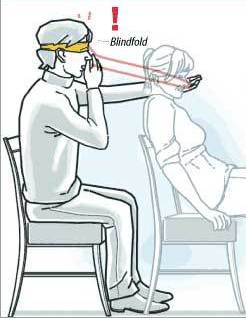Proprioreceptive illusions
Sense of body movement and position in space
- Muscle spindle -passive, static, & dynamic muscle stretch
- Goldi tendon organs -tendon
- Joint receptors are fast-adapting and signal joint angle
Tendon and spindle model
Proprioreceptive ilusions
- In the absence of movement & visual feedback, the perceived location of our hand may 'drift'
- This drift may be due to the information available from proprioception degrading over time
- usefull for WILD and OOBE project
- Vibrating the tendons of a muscle (at about 100-120Hz) mimics signals arising from normal muscle stretch
- This can 'fool' the brain into thinking that the muscle is being stretched
- pics body parts vibration treesholds and receptor frequenci sensitivity
Various vibrations inducted illusions
For example, vibration of the biceps brachii of the arm leads to the forearm feeling more extended than it actually is . When postural muscles are vibrated, various illusions of body motion can be elicited. For example, simultaneous vibration of the Achilles tendons of a standing subject restrained in position will cause the subject to experience forward pivoting in pitch about the ankles. The subject, if in total darkness, will exhibit nystagmoid eye movements with the slow phase compensatory for the direction of apparent self-displacement. If a visual target is presented for the subject to fixate, it will be seen to move in the direction of apparent self-motion and to displace ahead of the subject in the same direction . Thus, the visual target motion has the same characteristics as the oculogyral illusion described above, and a similar physiological explanation in terms of suppression of involuntary eye movements can account for its properties. Vibration of neck muscles leads to illusions of head rotation and displacement In fact, with vibration of the appropriate skeletal muscles, apparent motion and displacement of the body or its segments can be elicited in virtually any desired configuration. If visual or auditory targets are present, their positions also are remapped in the direction of apparent body motion and displacement. For example, when a small target light is attached to the hand and illusory motion of the restrained forearm is elicited by vibration of the biceps brachii or triceps muscles, the target light will be seen to displace physically in the direction of the apparent motion of the hand. This phenomenon is known as the oculobrachial illusion .
Pinocchio’s Effect
- gently stroking both noses,after about 1 minute, more than 50% of the subjects report their nose as incredibly long
- Vibrator version
- vibrator is applied to the biceps tendon while one holds one’s nose with the hand of that arm. The vibrator stimulates muscle spindles in the biceps that would normally be stimulated by the muscle’s stretching, creating a kinesthetic illusion that the arm is moving away from the face. Because the fingers holding the nose are still giving tactile information of being in contact with the nose, it appears that the nose is moving away from the face too, in a form of perceptual capture. Similar phenomenon happens using the blindfolded method.
Propriroceptive laterization
The nondominant arm (the left for most people) was better at matching positions. Furthermore, the left arm/right brain superiority grew with the difficulty of the task.When visual cues were provided. As expected, the dominant arm excelled, but when only proprioception was allowed, the nondominant arm won every time.







